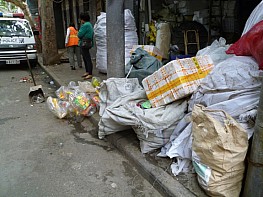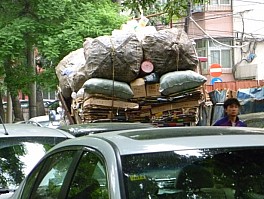July 2, 2013
Its vacation season again and time for another exciting addition to our occasional “Recycling Notes of Traveling NERC Staff.” As many solid waste professionals do when traveling, Lynn Rubinstein, NERC’s Executive Director, took pictures of recycling in action in China.
Here’s her Recycling Travelogue –
On a recent trip to China, I witnessed many of the differences between how recyclables are collected and consolidated in China as compared to in the U.S. The primary difference was how remarkably visible it was: recycling opportunities, collection, consolidation, and movement to markets. It was all right there and obvious.


No matter the size of  the community, there was public space recycling containers alongside non-recycling containers. These were seen on sidewalks, in airports, in train and bus stations, and at toll booths. My favorite was at a toll booth on an airport access road in Hefei, which offered the choice of ‘organism’ or ‘recyclable’. This was, however, the only organics diversion I saw.
the community, there was public space recycling containers alongside non-recycling containers. These were seen on sidewalks, in airports, in train and bus stations, and at toll booths. My favorite was at a toll booth on an airport access road in Hefei, which offered the choice of ‘organism’ or ‘recyclable’. This was, however, the only organics diversion I saw.
At the Beijing Airport, the recycling containers even offered battery recycling and told us that the containers were made of Tetra Pak cartons.
Transfer stations included neighborhood affairs, right in the middle of market streets and daily life. Unfortunately, there was no evidence of organics diversion in these settings and organics were clearly the largest component of what was being collected.




While there were packer trucks in evidence in large cities for collecting garbage, more prevalent were small scale recycling collectors. Or really, given the size of their loads and ingenuity in consolidating them, not so small scale.
In addition to the public space recycling containers, there was general curbside recycling as well as business recycling, especially for cardboard and Styrofoam.
Commercial cardboard recycling collection was especially interesting. In Beijing one morning, I watched a man with a scooter-sized truck collecting cardboard from a retail store as it was opening for the day. The cardboard collector had a hand scale with a leaded weight and he weighed the cardboard by hanging it from the scale by the string it was tied with. He made a note of the weight, approached the front door of the business – but did not enter – and waited a few moments to be noticed. He showed the slip with the weight and then handed over payment for the cardboard.

Enor mous loads of plastic being transported to recyclers were also a common sight, as were scooter collections from businesses for cardboard and plastic.
mous loads of plastic being transported to recyclers were also a common sight, as were scooter collections from businesses for cardboard and plastic.
Sadly, because of the quality of tap water, bottled water is ubiquitous. The good news is that plastic recycling is alive and well. In fact, I felt a little less guilty about my water bottles knowing that they were at least being saved the trip back to China for recycling.

By Lynn Rubinstein


Comments (0)
Add a Comment